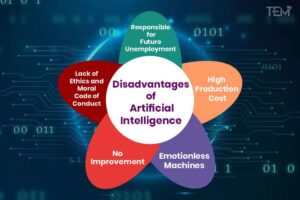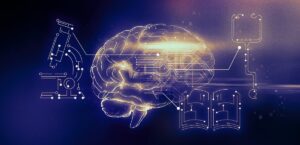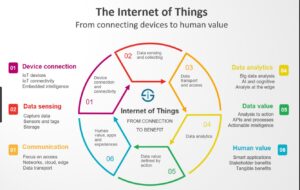What are the top 5 drawbacks of AI?
The Top 5 Drawbacks of Artificial Intelligence
What are the top 5 drawbacks of AI has emerged as a technological marvel, revolutionizing various industries and aspects of our lives. From healthcare to finance, education to entertainment, AI has made significant inroads. However, amidst the excitement surrounding AI’s capabilities and potential, it’s imperative to shine a light on its drawbacks and the challenges it presents. In this extensive exploration, we delve into the top five drawbacks of AI, scrutinizing each in depth to gain a comprehensive understanding of the multifaceted issues surrounding this transformative technology.
1. Lack of Common Sense: The AI Paradox (What are the top 5 drawbacks of AI?)


At its core, AI is an ingenious system that learns from data and identifies patterns to make decisions. It’s a marvel of computational power, but it has a glaring limitation: a lack of common-sense reasoning.
The Limitation Unveiled
What are the top 5 drawbacks of AI? AI, despite its remarkable feats, doesn’t possess the innate common sense that humans have. While humans can navigate complex situations with an inherent understanding of what makes sense, AI relies on statistical correlations. This means that AI can make decisions that, from a human perspective, appear baffling and illogical.
Consider the scenario of an AI-powered autonomous vehicle encountering a novel and intricate traffic situation. A human driver might rely on common-sense reasoning to navigate it safely, but the AI could falter in making the same decisions. This limitation has profound implications, not only for safety but also for the broader acceptance of AI in various applications.
Conquering the Lack of Common Sense
What are the top 5 drawbacks of AI? – Addressing this limitation necessitates significant strides in AI research, particularly in the domains of natural language understanding and reasoning. Researchers are actively engaged in developing AI systems that can understand context and apply common-sense reasoning to their decision-making processes. Achieving this milestone would mark a significant breakthrough in AI development.
2. Bias and Fairness Issues: The Equity Challenge (What are the top 5 drawbacks of AI?)
One of the most pressing concerns associated with AI is the perpetuation of biases present in training data, leading to fairness and equity issues.
Unearthing the Bias Dilemma
What are the top 5 drawbacks of AI? – AI systems, particularly machine learning algorithms, rely on extensive datasets for training. These datasets often mirror the biases and prejudices existing in the real world. Consequently, AI can inadvertently inherit and propagate these biases, creating fairness and equity concerns.
Consider an AI-based hiring system trained on historical data that exhibits gender bias. Even if unintentional, the AI could continue to favor one gender over another in future hiring decisions, perpetuating gender disparities.
Mitigating Bias and Ensuring Fairness
Tackling bias and fairness issues represents a multifaceted challenge. It involves meticulous curation of training datasets to reduce biases, the development of algorithms that are more transparent and interpretable, and the adoption of fairness-aware machine learning techniques. Regulatory bodies and organizations are placing increasing emphasis on ethical AI guidelines to promote fairness and diminish bias in AI applications.
3. Privacy Concerns: The Delicate Balancing Act (What are the top 5 drawbacks of AI?)


AI systems, often reliant on extensive data, raise legitimate concerns about data privacy and security.
The Data Paradox
What are the top 5 drawbacks of AI effectiveness that hinge on data? The more data an AI system has access to, the better it can perform. This paradox presents a unique challenge: the very data that enhances AI’s capabilities also raises legitimate privacy concerns.
Consider voice assistants like Amazon’s Alexa and Apple’s Siri. To understand and respond to voice commands, they continually collect and transmit audio data. While this data is used to refine the performance of these systems, it raises significant questions about the privacy of recorded conversations.
Safeguarding Data Privacy
Ensuring data privacy while harnessing AI’s capabilities necessitates a delicate balancing act. It involves implementing robust data encryption, anonymization techniques, and strict access controls. Regulatory frameworks such as the General Data Protection Regulation (GDPR) in Europe set standards for data protection and privacy, mandating that organizations handle user data with the utmost care.
4. Job Displacement: The Human vs. Machine Dilemma
AI’s potential to automate tasks raises concerns about job displacement, unemployment, and economic disruption.
Shifting Workforce Dynamics


The automation capabilities of AI can significantly reshape the job landscape. Occupations that entail repetitive and rule-based tasks are particularly susceptible to automation. For example, in manufacturing, robots and AI-driven systems can replace human workers in tasks such as assembly and quality control.
Similarly, in the retail sector, cashier-less stores are automating checkout processes, potentially displacing human cashiers. In the financial industry, algorithmic trading has reduced the need for human traders.
The Imperative of Reskilling and Upskilling
To address the job displacement challenge, there’s an increasing focus on reskilling and upskilling the workforce. This involves providing training and education to help individuals acquire the skills needed for the jobs of the future. Governments, businesses, and educational institutions must collaborate to prepare the workforce for the evolving employment landscape.
5. Complexity and Dependence: The Enigma of AI Systems
As AI systems grow in complexity, understanding how they make decisions becomes a significant challenge. Lack of transparency can have profound implications, especially in critical applications.
The Black Box Conundrum


What are the top 5 drawbacks of AI? Models, particularly deep neural networks, are often referred to as “black boxes” because their decision-making processes can be challenging to fathom. This lack of transparency can lead to a lack of trust in AI systems, particularly in applications where human lives are at stake.
In healthcare, for instance, AI systems that aid in medical diagnoses must be transparent in their decision-making processes to earn the trust of healthcare professionals and patients.
Advancing Explainable AI
To tackle the complexity and dependence of opaque AI systems, the field of explainable AI (XAI) is gaining prominence. XAI aims to create AI systems that can explain their decisions in a manner understandable to humans. This involves techniques like generating explanations for AI decisions, making AI decision processes more interpretable, and enhancing the transparency of AI systems.
